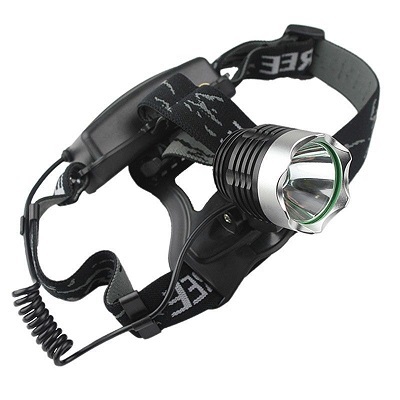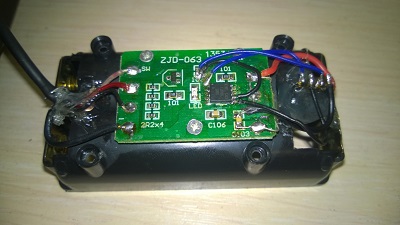A new heart for the Chinese lantern
Having bought a lot of Chinese lanterns, with power from 100 to 16,000 lumens, I was not satisfied.
In most cases, the flashlight does not give out the luminous flux declared by the seller. This is due to the fact that sellers at best indicate the maximum luminous flux that an installed LED module can give, but as a result of saving on materials, the LED works, if you're lucky, half of its maximum. Thin wires are used to limit the current, this eliminates the need for a direct current source and limits itself to a simple PWM controller with a power switch.

As a donor, the “2500Lm CREE XM-L T6 LED Headlamp” was selected at a price of $ 12, and after a year of use the PWM controller CX2812 died. This controller has three outputs for load, two inputs for setting operating modes and one input for a mode switching button. The first unpleasant moment of almost any Chinese flashlight for me was the presence of Strobe and SOS modes. In the case of this controller, it is enough to apply a logical unit to the input of OPT1 and out of the five modes, only three will remain (High, Low, Off). If a unit is applied to both OPT inputs, then the Low mode will also disappear.

The seller claims that the Cree XM-L T6 LED is used in the flashlight and it fries as much as 2500 lumens at maximum speed. On the Cree website for this LED, aperture of 100 lumens per watt and a maximum power of 10 watts are declared. In fact, the XM-L U2 LED is used, its characteristics are not very different from T6, but due to the thickness of the wires, only 1.1A reaches the LED, which at a battery voltage of 4.1V is 4.51W. It turns out that at maximum mode the flashlight emits about 451 lumens. The light meter shows 420 lumens, and this is quite far from the 2500.

The driver circuit is nowhere simpler and we will not complicate it. The ATtiny85 microcontroller was chosen as the new stone heart, although ATtiny13 (a) would have been enough, but it was not at hand in the right case. The mode switch button successfully hit the leg of PB2 / INT0, but the base of the transistor turned out to be connected to the RESET output. Having the hardware PWM on board, it was decided to use it, so the track leading to the RESET was cut, and the base of the transistor was connected by a jumper to the output PB1 / OC0B. For ease of programming, the necessary pins were brought out. The wires are fixed by hot-melt glue nozzles. The wires from the batteries to the board are replaced with slightly thicker ones.

The firmware was built in Arduino 1.0.6, the Arduino Nano was used as the programmer. The fuses were installed in accordance with the “ATtiny85 @ 1 MHz (internal oscillator; BOD disabled)” scheme. The firmware weight in binary form is currently 278 bytes. In the off state, the flashlight consumes 0.3 μA, with a short press on the button, the minimum mode is turned on, consumption increases to 7.6 mA. To turn off, briefly press and release the button. If you continue holding the button, the brightness will gradually increase to the maximum. Partial replacement of the wires did not give a significant increase in brightness, because the wires from the power supply to the head remained a bottleneck. At the moment, at maximum mode, the consumption is 1.2A, the battery voltage is 4.2, it turns out about 500 lumens.
But even despite the fact that Chinese sellers indicate several times overstated indicators for luminosity, often even the minimum of the proposed mode was too bright for me. After the alteration, the minimum mode is enough to not stumble at night on a forest path or use a flashlight as a night lamp when spending the night in a cave. In total, literally in a couple of hours, from a dead flashlight, I managed to make a flashlight of my dreams. I hope my experience will be useful to someone. The code is available at HeadLamp.ino .
Update 04/02/2015: After thinking a little, I added the ability to instantly turn on the flashlight to the maximum mode (two quick clicks), as well as the strobe mode (three quick clicks). To activate these modes, you need to uncomment the corresponding defines at the beginning of the code.
In most cases, the flashlight does not give out the luminous flux declared by the seller. This is due to the fact that sellers at best indicate the maximum luminous flux that an installed LED module can give, but as a result of saving on materials, the LED works, if you're lucky, half of its maximum. Thin wires are used to limit the current, this eliminates the need for a direct current source and limits itself to a simple PWM controller with a power switch.

As a donor, the “2500Lm CREE XM-L T6 LED Headlamp” was selected at a price of $ 12, and after a year of use the PWM controller CX2812 died. This controller has three outputs for load, two inputs for setting operating modes and one input for a mode switching button. The first unpleasant moment of almost any Chinese flashlight for me was the presence of Strobe and SOS modes. In the case of this controller, it is enough to apply a logical unit to the input of OPT1 and out of the five modes, only three will remain (High, Low, Off). If a unit is applied to both OPT inputs, then the Low mode will also disappear.

The seller claims that the Cree XM-L T6 LED is used in the flashlight and it fries as much as 2500 lumens at maximum speed. On the Cree website for this LED, aperture of 100 lumens per watt and a maximum power of 10 watts are declared. In fact, the XM-L U2 LED is used, its characteristics are not very different from T6, but due to the thickness of the wires, only 1.1A reaches the LED, which at a battery voltage of 4.1V is 4.51W. It turns out that at maximum mode the flashlight emits about 451 lumens. The light meter shows 420 lumens, and this is quite far from the 2500.

The driver circuit is nowhere simpler and we will not complicate it. The ATtiny85 microcontroller was chosen as the new stone heart, although ATtiny13 (a) would have been enough, but it was not at hand in the right case. The mode switch button successfully hit the leg of PB2 / INT0, but the base of the transistor turned out to be connected to the RESET output. Having the hardware PWM on board, it was decided to use it, so the track leading to the RESET was cut, and the base of the transistor was connected by a jumper to the output PB1 / OC0B. For ease of programming, the necessary pins were brought out. The wires are fixed by hot-melt glue nozzles. The wires from the batteries to the board are replaced with slightly thicker ones.

The firmware was built in Arduino 1.0.6, the Arduino Nano was used as the programmer. The fuses were installed in accordance with the “ATtiny85 @ 1 MHz (internal oscillator; BOD disabled)” scheme. The firmware weight in binary form is currently 278 bytes. In the off state, the flashlight consumes 0.3 μA, with a short press on the button, the minimum mode is turned on, consumption increases to 7.6 mA. To turn off, briefly press and release the button. If you continue holding the button, the brightness will gradually increase to the maximum. Partial replacement of the wires did not give a significant increase in brightness, because the wires from the power supply to the head remained a bottleneck. At the moment, at maximum mode, the consumption is 1.2A, the battery voltage is 4.2, it turns out about 500 lumens.
But even despite the fact that Chinese sellers indicate several times overstated indicators for luminosity, often even the minimum of the proposed mode was too bright for me. After the alteration, the minimum mode is enough to not stumble at night on a forest path or use a flashlight as a night lamp when spending the night in a cave. In total, literally in a couple of hours, from a dead flashlight, I managed to make a flashlight of my dreams. I hope my experience will be useful to someone. The code is available at HeadLamp.ino .
Update 04/02/2015: After thinking a little, I added the ability to instantly turn on the flashlight to the maximum mode (two quick clicks), as well as the strobe mode (three quick clicks). To activate these modes, you need to uncomment the corresponding defines at the beginning of the code.
